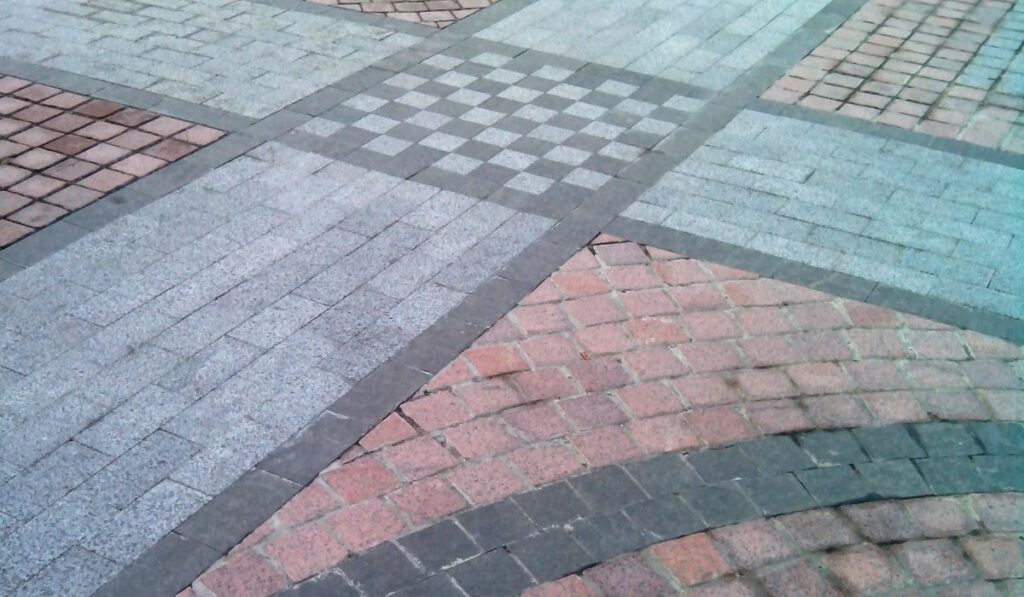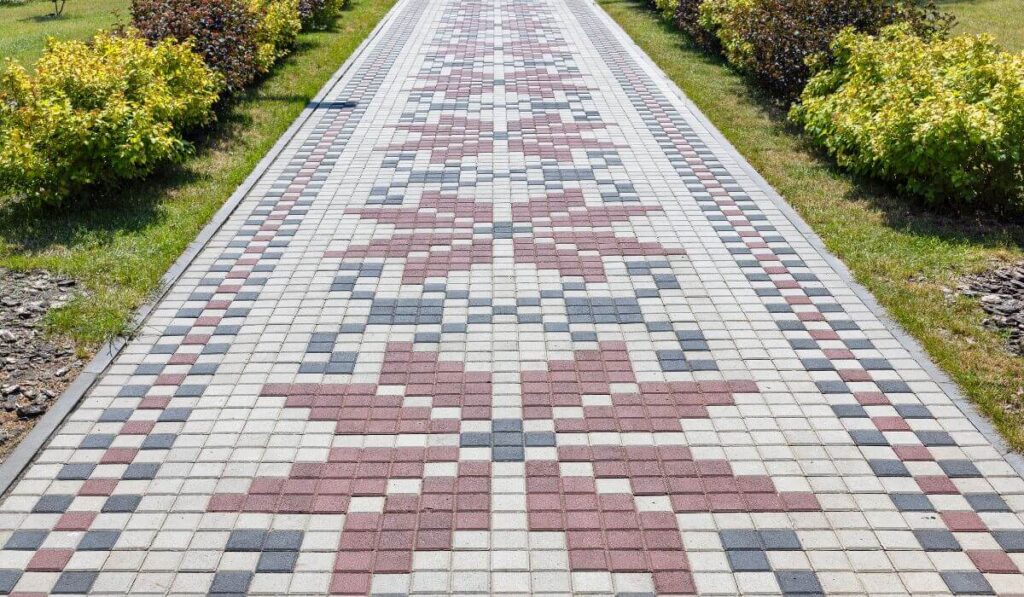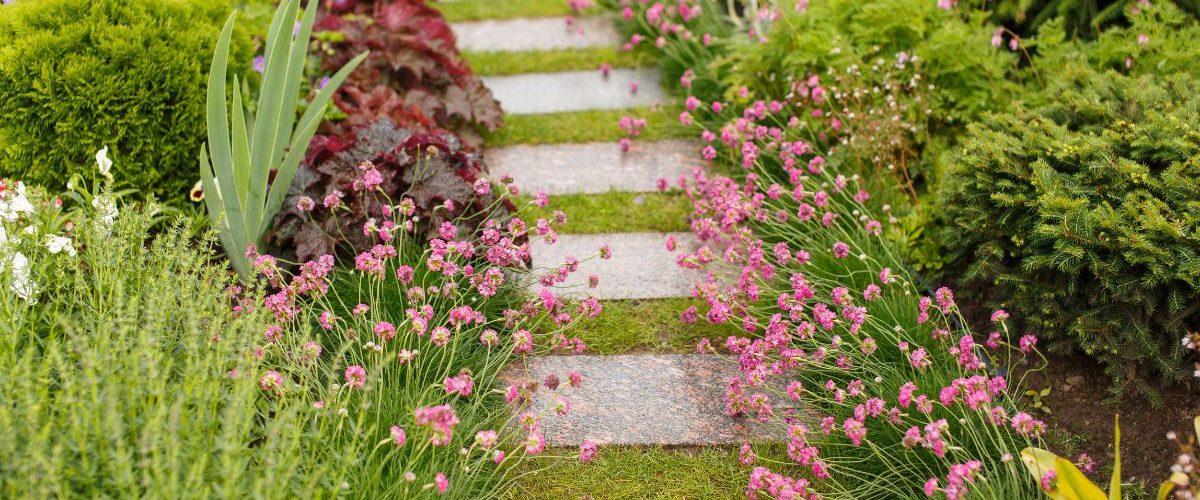Are you contemplating giving your Gig Harbor residence’s exterior area an upgrade with either slabs or pavers, but finding it hard to decide which option is best for you? This piece will delve into the primary distinctions between slabs and pavers, covering aspects such as the types of materials they’re made of, the process of installing them, their costs, longevity, and what it takes to keep them looking great.
We will also discuss factors to consider before deciding and provide step-by-step guides on installing slabs and pavers. We will highlight the common uses of slabs and pavers in various outdoor settings. Stay tuned to make an informed choice for your next outdoor project!
What Are Slabs and Pavers?
Slabs and pavers are common in landscaping and outdoor design, offering durability and aesthetic appeal to various outdoor spaces.
Slabs are typically large, flat pieces of stone or concrete, while pavers are smaller units that can be interlocked to create a cohesive surface.
Slabs are commonly made of concrete, natural stone, or porcelain, providing a solid base for outdoor features.
On the other hand, pavers are versatile and come in various shapes and colors, making them ideal for creating intricate patterns like herringbone or basketweave designs.
What Are The Main Differences Between Slabs and Pavers?
The primary distinctions between slabs and pavers lie in their material composition, installation methods, and overall costs, influencing their suitability for various outdoor projects.
Concrete slabs are typically made from poured concrete, offering a solid and uniform surface well-suited for high-traffic areas like driveways and patios.
On the other hand, pavers are manufactured from various materials, such as brick, stone, or concrete blocks, allowing for more design flexibility and customization.
In terms of costs, poured concrete is generally more affordable upfront than pavers, making it a popular choice for budget-conscious projects.
Though more expensive, Pavers can offer long-term cost savings through easier repair and maintenance due to their individual unit structure.
Material Composition
The material composition of slabs typically involves poured concrete, while pavers offer a range of options, including natural stone, decorative concrete, and paving bricks, to create diverse design aesthetics.
Concrete slabs are known for their durability and strength, making them ideal for driveways, patios, and walkways. On the other hand, pavers provide a more customizable approach, with materials like natural stone adding a touch of sophistication to outdoor spaces. Installing paving bricks offers a classic look, while decorative concrete allows for unique patterns and colors.
Each material brings its charm to landscaping projects, catering to different styles and preferences. By selecting the right material, you can easily enhance the beauty and functionality of your outdoor spaces.
Installation Process
Installing concrete slabs is a labor-intensive process involving pouring and leveling concrete, whereas laying pavers requires meticulous placement of individual interlocking pieces, often sealed with a protective sealant for durability.
Concrete slabs demand meticulous preparation of the subbase, ensuring proper compaction to prevent future settlingsetteling and cracking. The installation typically involves framing the area, pouring the concrete mix, and leveling it with screeds and floats.
In contrast, interlocking pavers require more precision due to their placement, emphasizing the importance of maintaining uniform spacing for a cohesive appearance. Once laid, pavers are often topped off with a protective sealant to enhance their resistance to stains, color fading, and longevity.
Cost
When considering costs, concrete slabs generally have lower material costs upfront compared to individual pavers. Still, the overall cost may vary based on the concrete surface’s size and the paver design’s complexity.
While concrete slabs may be more economical regarding initial material expenses, the total project cost can be influenced by site preparation, labor costs, and ongoing maintenance requirements. On the other hand, individual pavers often come with higher material costs but offer versatility in design options and easier repair or replacement of damaged units, potentially saving money in the long term.
Durability
Durability Durability is a crucial factor, with concrete slabs offering a lifetime guarantee against ground movement. At the same time, pavers are known for their ability to allow water drainage and withstand varying weather conditions.
Concrete slabs exhibit impressive ground movement resistance, making them a reliable choice for areas prone to shifting soil or seismic activity. Their water retention capabilities contribute to the prevention of erosion and soil runoff, enhancing the overall stability of the surface. When considering the impact of weather conditions,, both concrete slabs and pavers undergo rigorous testing to ensure resilience against extreme temperatures, moisture, and UV exposure.
Maintenance
Maintenance requirements differ between concrete slabs and pavers, with slabs prone to weed growth and protective sealants. In contrast, pavers need periodic releveling due to gravel base settling, especially in areas with frequent thaw cycles.
In terms of concrete slabs, regular inspections for weed intrusions and the application of protective sealant are crucial steps to maintain their longevity.
On the other hand, pavers require extra attention to the base material, as gravel settling over time may result in uneven surfaces. This settling is often more pronounced in regions exposed to drastic temperature changes with thaw cycles. Adjusting the gravel base and ensuring proper drainage can help prevent shifting and sinking, preserving the evenness of the paver surface.

Which One Should You Choose?
Deciding between concrete slabs and pavers depends on factors such as expected foot traffic, desired aesthetics, and the long-term value each option offers for your outdoor space.
Concrete slabs are popular for high-traffic areas due to their durability and low maintenance requirements. On the other hand, pavers provide a versatile option, allowing for intricate designs and easy replacements if needed. When considering aesthetics, concrete slabs offer a sleek, modern look, while pavers can create a more rustic or traditional feel.
Ultimately, the decision between concrete slabs and pavers comes down to personal preference, budget considerations, and the specific requirements of your outdoor space. Evaluating the pros and cons of each option about your needs will help you make an informed choice that adds more value to your property.
Factors to Consider Before Choosing Between Slabs and Pavers
Before making a decision, evaluate whether you prefer a DIY project or a professional installation. , Also, consider the impact on resale value for options like a new patio, and account for factors like excavation requirements that may influence your choice between slabs and pavers.
When deciding between concrete slabs and pavers, one crucial aspect to contemplate is the extent of excavation needed. Concrete slabs often require heavier excavation work as compared to pavers due to their solid nature, which might impact your timeline and budget. Understanding the differences in excavation can help you make an informed decision based on your preferences on for project duration and cost.
How To Install Slabs and Pavers?
The installation process for slabs and pavers involves multiple action steps. These include preparing the ground, selecting appropriate materials like brick, and carefully laying out the elements to create a durable and visually appealing walkway or patio.
Before you start the installation, it’s crucial to mark out the area where the walkway or patio will be constructed.
Next, dig down to the required depth, ensuring a level base for the slabs or pavers. You can use a hand tamper or plate compactor to compact the soil.
Once the ground is compacted, lay a geotextile fabric to prevent weed growth. Then, spread a layer of sand over the fabric to create a smooth base for the bricks or stones.
Steps for Installing Slabs
Installing concrete slabs involves precise measurements per square foot or inch, ensuring a stable base with proper drainage to prevent water pooling or ground instability.
Before beginning the installation process, it’s crucial to mark the areas accurately for the concrete slabs. Measure the designated space precisely, ensuring the dimensions are correct to avoid any irregularities.
Once the measurements are finalized, focus on preparing the ground beneath. This step is vital as it will provide the necessary stability for the slabs over time. It’s also essential to address potential drainage challenges by creating a slight slope away from buildings or towards existing drainage systems. Proper drainage will help prevent water accumulation, which could lead to damage in the long run.
Steps for Installing Pavers
Installing pavers requires careful placement of individual pavers, compacting them to withstand foot traffic and external pressures, and creating a long-lasting and visually appealing walkway or patio while considering material costs.
Starting with the correct placement of pavers is crucial to ensuring a stable and aesthetically pleasing surface for your walkway. Each paver must be positioned precisely to maintain consistent spacing and alignment throughout the project. After the initial placement, compacting the pavers is essential to increase their durability and resistance to pressure, preventing shifting or sinking over time. By using more pressure during compaction, you can achieve greater depth and stability, enhancing the overall strength of the walkway or patio. Managing material costs efficiently by sourcing quality pavers within your budget can lead to a cost-effective yet durable installation.
What Are The Common Uses of Slabs and Pavers?
Slabs and pavers find versatile applications in various outdoor settings, from creating beautiful pool decks and walkways to supporting functional elements like retaining walls and boulder arrangements.
These durable materials are aesthetically pleasing and offer structural integrity when used to construct retaining walls. By incorporating concrete slabs and pavers into your landscaping projects, you can efficiently manage erosion control and create visually appealing borders for raised gardens or terraced areas. The flexibility of these materials allows for intricate designs that seamlessly blend with natural elements like boulders for a harmonious outdoor space.

Patios and Walkways
Slabs and pavers are commonly used for constructing patios and walkways, offering opportunities for creative designs, low maintenance requirements, and flexibility in material choices per square foot for personalized outdoor spaces.
One of the key advantages of utilizing pavers is their exceptional durability, which enables them to withstand varying weather conditions and heavy foot traffic. In terms of maintenance, regular cleaning and occasional sealing are typically required to keep pavers looking their best. The diverse range of materials available, including concrete, natural stone, and brick, allows homeowners to achieve a unique aesthetic that complements their outdoor surroundings. The efficient utilization of paver maintenance and materials ensures cost-effective and long-lasting results, making them popular for outdoor projects.
Driveways
For driveway applications, both slabs and pavers can create visually appealing surfaces that withstand ground movement and heavy vehicle pressure, and they require professional installation for long-term durability.
When considering driveway projects, the choice between concrete slabs and pavers can significantly impact the space’s overall aesthetic appeal and functionality. Concrete slabs offer a sleek and modern look, ideal for those seeking a clean, minimalist design. On the other hand, pavers allow for more design versatility, with various colors, shapes, and patterns to choose from, enabling homeowners to customize their driveways to suit their preferences.
Regarding pressure resistance, both slabs and pavers are durable options that can withstand the weight of vehicles and regular use. It’s crucial to note that properly installed concrete slabs tend to offer greater greater resistance to pressure due to their solid, uniform structure. Pavers, while robust, rely on proper edge restraints and jointing sand for stability.
Slabs’ and pavers’ longevity and performance heavily depend on correct installation techniques. To prevent issues related to ground movement, including such as sinking or shifting, it is essential to ensure that the base material is properly compacted and adequate drainage is in place. Professional installation ensures a level surface and reduces the risk of cracks or uneven settling over time.
Pool Decks
When used for pool decks, slabs and pavers offer durable and safe surfaces that can withstand varying weather conditions, involve excavation for proper installation, and benefit from protective sealants to maintain walkway integrity around the pool area.
Slabs and pavers are popular choices for pool deck designs due to their versatility and resilience. Their weather resistance ensures that they remain intact despite exposure to sun, rain, and other harsh elements, making them ideal for outdoor settings.
The installation process, which typically involves excavation to create a stable foundation, is crucial for ensuring the longevity and stability of the deck. Applying protective sealants not only enhances their appearance but also helps prevent damage from foot traffic and pool water exposure.
Garden Paths
Creating garden paths with slabs and pavers involves mutiple steps. These include selecting suitable materials, ensuring a stable ground beneath for support, and integrating pathways seamlessly with planting beds to enhance the overall landscape design.
Regarding material choices for garden paths, slabs and pavers offer a diverse range of options to suit various aesthetics and functional needs. Whether opting for natural stone for a rustic feel or concrete pavers for a modern touch, the selection can profoundly impact the path’s visual appeal.
Ground stability is crucial to prevent sinking or shifting, especially in high-traffic areas. By properly compacting the soil and using a base material like gravel or sand, the foundation can adequately support the weight of the pathway materials.
Integrating pathways with planting beds strategically adds a harmonious touch to the garden landscape, blending hardscape and softscape elements for a cohesive look. By aligning the paths with the planting beds, you can create a seamless flow throughout the garden, encouraging exploration and enhancing the overall design.
Transform Your Outdoors: Choosing Between Concrete Slabs and Pavers
The choice between concrete slabs and pavers should be guided by weather conditions, desired aesthetics, value considerations, and expected foot traffic to ensure the optimal selection for your outdoor project.
Concrete slabs are more durable and require less maintenance over time, providing more value in the long run. Pavers, on the other hand, offer flexibility in design and are easier to repair if damaged. When assessing your outdoor space, consider the adaptability of each material to varying weather conditions.
It’s crucial to evaluate the foot traffic that the area will experience. High-foot-trafficHigh-foot traffic areas may benefit from the sturdiness of concrete slabs, while pavers can be a better choice for areas with lighter traffic where design versatility is key.
For expert advice and professional landscaping services in Gig Harbor, WA, contact Garland Landscape at (253) 858-5328. Transform your outdoor space with our expertise!
Frequently Asked Questions
What is the difference between a concrete slab and pavers?
A concrete slab is a solid, continuous surface, while pavers are individual units that interlock to form a flexible surface.
How does a typical concrete slab differ from a paver patio?
A typical concrete slab is a uniform, continuous surface, while a paver patio consists of individual paving stones arranged creatively.
What is the process of paver installation compared to concrete installation?
Paver installation involves laying individual paving stones with precision, providing flexibility in design. Concrete installation results in a continuous surface poured in place.
Are there differences in costs between concrete and pavers?
Concrete costs per square foot may vary from pavers, and factors like materials, installation, and maintenance contribute to overall expenses.
How do concrete repairs compare to maintaining pavers?
Concrete may crack and stain over time, requiring repairs or replacement. Pavers are generally easy to maintain, with individual units allowing for simple replacements, if needed.
What are the benefits of using stamped concrete in comparison to paving stones?
Stamped concrete provides a decorative appearance, is easy to maintain, and offers customization options, making it a versatile choice for patios and walkways.
Can you elaborate on pavers vs concrete in terms of design and aesthetics?
Pavers offer diverse designs and shapes, allowing for creative patterns and flexibility. Concrete provides a continuous surface but may lack the varied aesthetics of individual pavers.
How does the weight-bearing capacity of pavers compare to concrete slabs?
Pavers distribute weight effectively, making them suitable for various loads. Concrete slabs are generally robust but may require specific reinforcements for heavy loads.
Do pavers or concrete retain water differently?
Pavers allow water to drain through joints, preventing pooling. Concrete surfaces may require additional measures to address drainage issues.
Can I use pavers for a driveway, and how does it compare to a concrete driveway?
Pavers can be used for driveways, offering design flexibility. Concrete driveways provide a continuous surface but may lack the individuality of paver designs.

As the owner of Garland Landscape, Chris brings over 19 years of experience in landscaping and hardscaping to every project.

